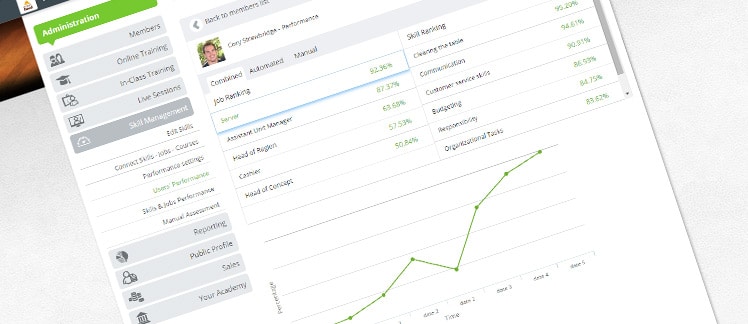October 15, 2015
7 Min. Read

Chances are that your employees have skills you are not aware of — skills that might be ideal for filling new job openings in your company. If you identified these skills and supported their development, you could promote from within your company with greater confidence.
What’s more, identifying your employees’ skills and supporting their development could boost their job satisfaction, productivity, and personal happiness – and, as a result, your bottom-line. Several research studies have shown that companies who focus on their employees’ strengths gain significant advantages.
But your employees’ skills may be lying dormant – because you haven’t identified them and supported their development. What’s stood between many companies and their employees’ hidden skills is having a convenient, easy-to-use system.
That’s where Schoox skill and performance management module comes in – because it provides everything you need. What’s more, tapping into employees’ existing skills with your learning management system is the next logical step in the popular strengths-management movement that’s been underway for the past several decades.
If you haven’t yet launched an effective way to manage your employees’ skills and performance, here are three reasons why you’ll want to — using Schoox easy-to-use employee skills and performance management module.
Employees Benefit from Skills Management
Several research studies conducted over the past several years have discovered clear evidence that employees gain many benefits when their employers work to help discover and manage their skill development including these:
- Employee Job Satisfaction. Employees like to feel that their talents are appreciated. When employees’ strengths are noticed and acted on by their employers, employees report higher job satisfaction. It’s been proven time and again that it’s important for business leaders to recognize existing talent and engage the employee in making the most of his or her abilities.
- Higher Job Engagement. In a Gallup study, 37 percent of employees said their supervisor focused on their strengths. Nearly 61 percent of these employees said they were engaged in their jobs, which is twice the average of U.S. workers nationwide. Also, active disengagement in this group fell dramatically to one percent. Employee engagement has been significantly correlated to business outcomes, including profitability, turnover, safety, and customer satisfaction.
- Personal Development. For many workers, the benefits of maximizing their strengths leads not just to higher job engagement and a better career, but also to better lives. The more hours each day that employees can use their strengths to do what they do best, the less likely they are to report experiencing worry, stress, anger, sadness, or physical pain. What’s more, the more hours per day that employees use their strengths, the more likely they are to report having ample energy, feeling well-rested, being happy, smiling, and laughing. These wellbeing advantages also benefit employers through higher productivity, fewer sick days, lower incidence of chronic disease, and fewer health-related expenses.
Companies Gain Valuable Benefits from Managing Employees’ Skills
Many studies have found that companies gain significant advantages when they have established programs that recognize and develop employees’ skills including:
- Employee Retention. It costs an organization up to three times an employees’ salary to attract, hire, and train a new employee. Research finds that over 80 percent of people who leave organizations do so, not for monetary reasons, but because they are not fulfilled. One of the ways employees feel fulfilled and keep their jobs is when their managers recognize and reward their strengths.
- More Productive Jobsite. When employees are engaged in their jobs and their strengths are valued and supported, it creates a culture that fosters high performance and greater productivity. Strengths-based leadership has been identified as a core element of fostering employee optimism, engagement, and project performance — all of which leads to significantly higher productivity. Gallup’s data shows teams that focus on strengths every day have 12.5 percent greater productivity.
- Better Job Matching. A recent report showed that a growing skills gap is the cause of many hiring woes and challenges faced by recruiters. A skills gap is defined as “a significant gap between an organization’s skill needs and the current capabilities of its workforce.” A proactive employee skill and strength management system could help companies identify current employee who possess the skills they need for other jobs within the company.
- Greater Business Success. Gallup found that employees who feel engaged at work and who can use their strengths in their jobs are more productive and deliver higher quality work. Based on findings like these Gallup concluded that a strengths-based management approach is the best way to improve employee productivity, engagement, and satisfaction — and, therefore, the company’s overall success.
Schoox Makes it Easy to Manage Your Employees’ Skills
Recognizing the value of adopting a skills-based approach to employee training, Schoox created a powerful employee skills management module within its learning management system. As a result, Schoox makes it easy to manage employees’ skills, because all of the easy-to-use functionality is tied in with your online training program.
To start discovering and promoting your employees’ strengths and skills, just follow this simple six-step process:
- Identify Skills to Manage. The process begins with determining which skills you want to develop in your employees through your online training center. Schoox comes with over 300 skills already built into the system. It’s easy to add and delete skills in the administrative panel. And you can also create new skills unique to your company and your jobs. You can also gather skills into groups to make them easier to organize.
- Assign Skills to Jobs and Courses. Connect the skills you want to develop with the appropriate courses in your training center and to the job roles to which they align. The exam questions in your courses need to reflect the assigned skill sets.
- Weight Skills Values. Weight the importance of each skill to each job.
- Connect Skills to Course Exams. Schoox uses a complex set of algorithms in combination with how you’ve set up your academy’s skills to rate each employee based on their exam scores. Other factors are also considered, like the number of attempts an employee needed to pass an exam and the average score of all employees.
- Weight Automated and Manual Assessments. Decide the importance of any automated assessment in relationship to any manual assessment that the instructors provide. Instructors can weight in manually on information the exams may have missed.
- Dive Into Employees’ Results. See each employee’s skills in relationship to his or her training and their peers. You’ll be able to see, for example, which employee has the skill set required for a management promotion.
Why wait any longer to reap the proven rewards of employee skill management? Launch your Schoox skill and employee management module today – and begin accessing the power and benefits of employee skills and performance management.



